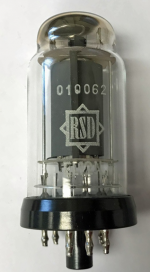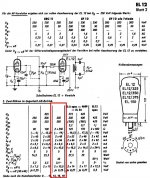I recently bought an old PA amp (a Champion) and it came with some valves I had not encountered before, EL12 and EF12. They use the Y8A base, which is apparently quite common on older European electrical equipment.
EL12's can be bought NOS for quite reasonable money, especially on the German version of a certain auction site, but the only reference I could find for them here was a big thumbs up when used in a guitar amp.
Does anyone have any experience of their use in hifi?
EL12's can be bought NOS for quite reasonable money, especially on the German version of a certain auction site, but the only reference I could find for them here was a big thumbs up when used in a guitar amp.
Does anyone have any experience of their use in hifi?
Attachments
We have been using the EL12N as well as many other of the EL family, in our headphone amps from Feliks Audio. They are quite good, in either the driver or power sockets of our amps. I am using the Euforia at present for the last year or so, and have experimented with many tubes for it. Designed for the 6sn7 drivers and 6N13S as powers. El 11 mesh plates are also very good as drivers for audio. Have moved to a quad of Gold Lion KT88's for drivers and power tubes and turn in extrodinary fidelity.
Any more news on this tube? There do seem to be some available. Surprising since the Y8A base is long gone, and few people would want to use it these days.
The base is still available ...
Reichelt Y8A tube base
I have been thinking one option for tubes with out of the ordinary bases is to fit them on a chassis with a cutout like a Quad II, and have the base on a sub-chassis. Then, in principle, if one has some nice NOS tubes with odd bases, they can relatively easily be swapped into the chassis by switching the subchassis. Another advantage is keeping an overall low profile of the tubes, plus ventilation could also be easier if the opening for the tube base is quite large.
Does anyone do this?
Why 125-130 Ohm? The datasheet TS posted, gives 90 Ohm for single ended operation and 2 x 350 Ohm for class AB push-pull operation. In the note it is stated that for push-pull operation using seperate cathode resistors is mandatory (probably because of the high transconductance of the EL12N).
But maybe you were thinking of a different way to use the EL12N than in the datasheet.
But maybe you were thinking of a different way to use the EL12N than in the datasheet.
For a voltage of 350V (as approximately in a QUAD II amplifier) and a Push-Pull connection a pair of EL12 tubes needs a pair of 250 Ohms resistors, which result in 125 Ohms when replaced with just one. Due to the slightly lower current consumption of the EL12N compared to the KT66 (not much!), the voltage could be slightly higher than ~ 350V, so a value of ~ 130 Ohms for the cathode resistor might be more accurate. I have experience with EL12N because I made several guitar amplifiers with them with almost the same voltage conditions and I can say that they are very high quality, stable and tonally pleasing output tubes.
Attachments
Last edited:
Here is the quartet EL12N at 2 addresses for 82,75 Euro (USA 96,6$) tubes+shipping:
EL12N NOS – 1 Quartet RSD Tubes NOS/EL12N Tube Valve selected Quad | eBay
1 x EL12N-EL12 N-RSD/FSG Tube Tube Valvola Test Tube Tube New in Box | eBay
EL12N NOS – 1 Quartet RSD Tubes NOS/EL12N Tube Valve selected Quad | eBay
1 x EL12N-EL12 N-RSD/FSG Tube Tube Valvola Test Tube Tube New in Box | eBay
They do indeed seem to be still available. I ordered four and will be curious to see how they sound.
I looked at the old Klangfilm amps referred to previously and they are gorgeous. So are the Shindo Cortese amps which started off with the same F2A tubes, a totally different proposition, lost in the corridors of time apart from a few ridiculously expensive survivors. Maybe the EL12n is somewhere in the ballpark of a F2a, though doubtless not the real thing. The Cortese looks like it now ships with 300b outputs, which is hardly surprising in terms of current availability.
I looked at the old Klangfilm amps referred to previously and they are gorgeous. So are the Shindo Cortese amps which started off with the same F2A tubes, a totally different proposition, lost in the corridors of time apart from a few ridiculously expensive survivors. Maybe the EL12n is somewhere in the ballpark of a F2a, though doubtless not the real thing. The Cortese looks like it now ships with 300b outputs, which is hardly surprising in terms of current availability.
The F2a is a variant made for operation in multi-channel telephone communication devices, and the F2a11 is actually the same tube for the German “steel” socket of the “11” series and other commercial and medical devices. Although a common origin in development can be found with the EL12, the precision of the F2a series performance (F2a11 and F2a34), materials, uniformity, durability and reliability in operation is far above. I can reliably and through practice claim that the sound of a tube can be compared to F2a or F2a11 in a well-made audio amplifier, but also EL12, EL12 / 375 and EL12N sound very good. I have worked with all of the above, although not projects similar to the "Quad II" amplifier, but as they work well in other similar topologies, there is no reason for them to work poorly in "Quad II". I haven't had EL12-spez tubes for a very long time, and the amp I worked with in the mid-1970s worked, but I don't remember how it sounded anymore.
Last edited:
The EL12N has been prduced exclusively at the Mühlhausen tube factory in former GDR. In it's data and ratings, it is an equivalent to the old TELEFUNKEN EL12 Spez, but has it's plate connection brought out to the socket instead of a top cap. Pinout is the same as with the EL12, but it's construction, omitting that pinch stem, is much newer.
F2a's have nothing to do with EL12's, with the exception of the same socket type between F2a11 and EL11/12.
Best regards!
F2a's have nothing to do with EL12's, with the exception of the same socket type between F2a11 and EL11/12.
Best regards!
Hi Kay,
Do you know the difference between these two types of EL12 on the Conrad site?
EL12N and EL12/375
They have some quite unusual tubes for sale there - 811 equivalents, for example, and also the only site I could find with a PCB suitable B8A socket!
Cheers, Richard
Do you know the difference between these two types of EL12 on the Conrad site?
EL12N and EL12/375
They have some quite unusual tubes for sale there - 811 equivalents, for example, and also the only site I could find with a PCB suitable B8A socket!
Cheers, Richard
Yes, very curious. They look identical and specs are same except for height 95mm EL12n and 110mm EL12/375.
There was an ST version it seems. Says "different maximum ratings" so maybe it could take more power. Looks like 375 is the maximum anode voltage rating. "A suffix /xxx indicates the max. voltage this tube is especially selected for, otherwise it's 250 V."
EL 12/375, Tube EL12/375; Rohre EL 12/375 ID2007, Vacuum Pen
TDSL Tube data [EL12/375]
There was an ST version it seems. Says "different maximum ratings" so maybe it could take more power. Looks like 375 is the maximum anode voltage rating. "A suffix /xxx indicates the max. voltage this tube is especially selected for, otherwise it's 250 V."
EL 12/375, Tube EL12/375; Rohre EL 12/375 ID2007, Vacuum Pen
TDSL Tube data [EL12/375]
Last edited:
- Home
- Amplifiers
- Tubes / Valves
- EL12N in hifi

